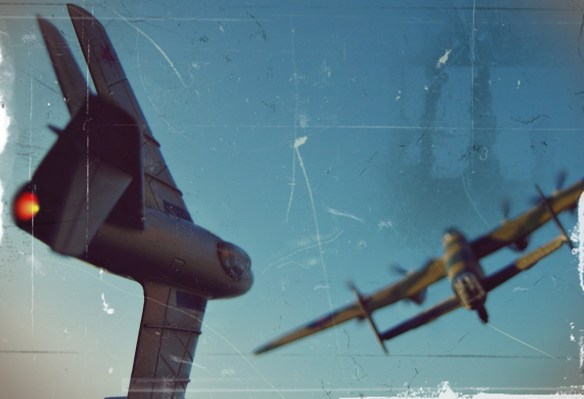On March 12, 1953 the Cold War suddenly turned very hot for the RAF. For it was on this day that Soviet fighters finally brought down a British aircraft, in an uneven contest between an ageing Avro Lincoln and a MiG-15 jet.
The first months of 1953 were a particularly tense time in the history of the undeclared conflict between the Soviet Union and the West. The nuclear arms race was at its most intense, the Korean War was still raging and the death of Stalin in early March had plunged the Kremlin into a leadership crisis. Meanwhile, the air forces of the West, primarily – but not exclusively – the USAF and RAF, were regularly conducting clandestine spy flights over Soviet territory, photographing sensitive military installations, testing response times of scrambled Soviet fighters and gathering electronic intelligence (ELINT), such as recording Russian radar emissions.
The Soviet Air Force reacted forcefully to these intrusions. In June 1952 a DC-3 of the Swedish Air Force, believed to be on a secret ELINT mission, was intercepted and shot down by a MiG-15 fighter over the Baltic, with the loss of all eight crewmen. Then, on March 10, 1953 a USAF F-84 Thunderjet was also shot down, again by a MiG fighter, this time after apparently breaching Czech airspace.
Nor were these incidents confined to military aircraft. On April 29, 1952 an Air France C-54 en route to West Berlin was badly damaged by two MiG-15s, necessitating an emergency landing at Tempelhof airport. It was later found to have been struck by no fewer than 89 cannon shells, though miraculously none of the passengers or crew were seriously injured.
Dire warning
It was against this backdrop of high tension in the skies over Central Europe that a 192 Sqn Avro Lincoln, attached to the Central Gunnery School at RAF Leconfield in Yorkshire, set out on what was later described by the British government as a “routine flight” to West Germany.
Piloted by 29-year-old Flight Sergeant Peter Dunnell, the big four-engined aircraft was the second of two Lincolns to take part in a fighter affiliation sortie across northwest Europe that day, testing NATO’s air defences. The first, flown by Flight Sergeant Denham, had already been subjected to aggressive buzzing by a pair of MiG-15s, even though it was flying within the British zone. The crew returned to Leconfield, shaken though unhurt. But the tense situation was about to escalate dramatically.
Two hours after Denham’s Lincoln took off from Leconfield, Dunnell’s aircraft (RF531), carrying a crew of seven – including Squadron Leader Harold Fitz, the newly appointed commander of 3 Sqn – set out, following the same route.
Whilst flying between Hamburg and West Berlin in Soviet-controlled East Germany, along the designated 20-mile wide air corridor allocated to British aircraft, RF531 apparently veered accidentally out of the air corridor and into East German airspace.
Two MiG-15s soon appeared and fired a warning burst at the aircraft. Realising their mistake, the crew immediately changed course and headed back to the British zone. But one of the Soviet pilots followed up the warning shots by raking the lumbering Lincoln with cannon fire.
Mortally damaged, the burning Lincoln went into a spiral. Of the three crewmen who succeeded in bailing out of the stricken aircraft, the parachute of one failed to deploy while the other two, according to the testimony of several German eyewitnesses on the ground, were shot in a firing pass by one of the MiG pilots whilst drifting helplessly down on their parachutes. The wreckage of the Lincoln was scattered over a wide area, much of it landing just inside the Soviet zone. All seven men aboard the Lincoln perished.
Tragic exercise
There have long been rumours that the Lincoln – a type often used at the time by the RAF on ELINT flights – was possibly on an intelligence-gathering mission, perhaps testing Soviet air defences, when it was intercepted and shot down. But according to Intelligence historian Richard Aldrich this was probably not the case.” The RAF Lincoln lost on March 12, 1953 was not directly involved in radio warfare or special duties,” he stated. “It was merely on exercise, and wandered out of one of the defined twenty-mile air corridors over the Soviet Zone between West Germany and Berlin.”
He adds, however, that “while the Lincoln had not been on an intelligence flight, its progress was being carefully tracked by a British SIGINT unit on the ground at RAF Scharfoldendorf in the British zone of Germany.”
While refusing to accept full responsibility, Moscow did issue an `expression of regret’ upon returning the bodies of the crew to RAF Celle. Six of the crew – Squadron Leader Fitz, Flight Lieutenant Stephen Wyles and Sergeants Ronald Stevens, George Long, William Mason and Kenneth Jones – were repatriated to the UK and buried with full military honours on March 19, 1953 in St Catherine’s Churchyard, close to their base in Leconfield. The pilot, Peter Dunnell, was buried in Colton Churchyard, Norfolk.
But other RAF aircraft certainly were engaged in intelligence-gathering flights around – and indeed over – the Iron Curtain at the time. Just five months after the Lincoln shoot-down a Canberra of 540 Sqn was reportedly intercepted and slightly damaged by MiG fighters while apparently on a photoreconnaissance mission over the Soviet Union.
Thankfully, however, never again would the RAF lose an aircraft to Soviet fighters over the Iron Curtain.
